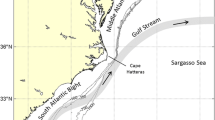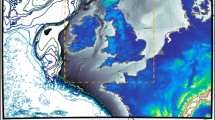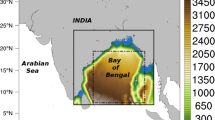Abstract
A coupled ocean and boundary layer flux numerical modeling system is used to study the upper ocean response to surface heat and momentum fluxes associated with a major hurricane, namely, Hurricane Dennis (July 2005) in the Gulf of Mexico. A suite of experiments is run using this modeling system, constructed by coupling a Navy Coastal Ocean Model simulation of the Gulf of Mexico to an atmospheric flux model. The modeling system is forced by wind fields produced from satellite scatterometer and atmospheric model wind data, and by numerical weather prediction air temperature data. The experiments are initialized from a data assimilative hindcast model run and then forced by surface fluxes with no assimilation for the time during which Hurricane Dennis impacted the region. Four experiments are run to aid in the analysis: one is forced by heat and momentum fluxes, one by only momentum fluxes, one by only heat fluxes, and one with no surface forcing. An equation describing the change in the upper ocean hurricane heat potential due to the storm is developed. Analysis of the model results show that surface heat fluxes are primarily responsible for widespread reduction (0.5°–1.5°C) of sea surface temperature over the inner West Florida Shelf 100–300 km away from the storm center. Momentum fluxes are responsible for stronger surface cooling (2°C) near the center of the storm. The upper ocean heat loss near the storm center of more than 200 MJ/m2 is primarily due to the vertical flux of thermal energy between the surface layer and deep ocean. Heat loss to the atmosphere during the storm’s passage is approximately 100–150 MJ/m2. The upper ocean cooling is enhanced where the preexisting mixed layer is shallow, e.g., within a cyclonic circulation feature, although the heat flux to the atmosphere in these locations is markedly reduced.







Similar content being viewed by others
References
Beven J (2005) Hurricane Dennis, 4–13 July 2005. Tropical Cyclone Report, National Hurricane Center
Bourassa MA (2004) An improved seastate dependency for surface stress derived from in situ and remotely sensed winds. Adv Space Res 33:1136–1142
Bourassa MA, Vincent DG, Wood WL (1999) A flux parameterization including the effects of capillary waves and sea . J Atmos Sci 56:1123–1139
Cione JJ, Uhlhorn EW (2003) Sea surface temperature variability in hurricanes: implications with respect to intensity change. Mon Weather Rev 131:1783–1796
DaSilva A, Young AC, Levitus S (1994) Atlas of surface marine data 1994, vol. 1: algorithms and procedures. NOAA Atlas NESDIS 6, U. S. Department of Commerce
Ellingsen IH (2004) Internal tides and the spread of river plumes in the Trondheim Fjord. Ph.D. dissertation, Norwegian University of Science and Technology, Trondheim, Norway
Fox DN, Teague WJ, Barron CN, Carnes MR, Lee CM (2002) The Modular Ocean Data Assimilation System (MODAS). J Atmos Ocean Technol 19:240–252
Holland WR, Chow JC, Bryan FO (1998) Application of a third-order upwind scheme in the NCAR Ocean Model. J Climate 11:1487–1493
Hodur RM, Pullen J, Cummings J, Hong X, Doyle JD, Martin P, Rennick MA (2002) The Coupled Ocean/Atmosphere Mesoscale Prediction System (COAMPS). Oceanography 15:88–98
Kara AB, Barron CN, Martin PJ, Smedstad LF, Rhodes RC (2005) Validation of interannual simulations from the 1/8° global Navy Coastal Ocean Model (NCOM). Ocean Model 11:376–398. DOI 10.1016/j.ocemod.2005.01.003
Large WG, McWilliams JC, Doney S (1994) Oceanic vertical mixing: a review and a model with a nonlocal boundary layer parameterization. Rev Geophys 32:63–403
Leipper DF, Volgenau D (1972) Hurricane heat potential of the Gulf of Mexico. J Phys Oceanogr 2:218–224
Mao Q, Chang SW, Pfeffer RL (2000) Influence of large-scale initial oceanic mixed layer depth on tropical cyclones. Mon Weather Rev 128:4058–4070
Martin PJ (1985) Simulation of the mixed layer at OWS November and Papa with several models. J Geophys Res 90:903–916
Martin PJ (1999) An ocean model applied to the Chesapeake Bay plume. In: Spaulding ML, Butler JL (eds) Estuarine and coastal modeling. Proceedings of the 6th International Conference, pp 1055–1067
Martin PJ (2000) A description of the Navy Coastal Ocean Model Version 1.0. NRL Report: NRL/FR/7322-009962, Naval Research Laboratory, Stennis Space Center, MS
Mellor GL, Yamada T (1982) Development of a turbulence closure model for geophysical fluid problems. Rev Geophys Space Phys 20:851–875
Morey SL, Martin PJ Martin, O’Brien JJ, Wallcraft AA, Zavala-Hidalgo J (2003) Export pathways for river discharged fresh water in the northern Gulf of Mexico. J Geophys Res 108: 3303. DOI 10.1029/2002JC001674
Morey SL, Zavala-Hidalgo J, O’Brien JJ (2005a) The seasonal variability of continental shelf circulation in the northern and western Gulf of Mexico from a high-resolution numerical model. In: Sturges W, Lugo-Fernandez A (eds) Circulation of the Gulf of Mexico: observations and models. Geophysical Monograph Series, pp 203–218. DOI 10.1029/161GM16
Morey SL, Bourassa MA, Davis XJ, O’Brien JJ, Zavala-Hidalgo J (2005b) Remotely sensed winds for episodic forcing of ocean models. J Geophys Res 110:C10024. DOI 10.1029/2004JC002338
O’Brien JJ (1967a) The non-linear response of a two-layer, baroclinic ocean to a stationary, axially symmetric hurricane: Part 1. Upwelling induced by momentum transfer. J Atmos Sci 24:197–207
O’Brien JJ (1967b) The non-linear response of a two-layer, baroclinic ocean to a stationary, axially symmetric hurricane: Part 2. Upwelling and mixing induced by momentum transfer. J Atmos Sci 24:208–215
Price JF (1981) Upper ocean response to a hurricane. J Phys Oceanogr 11:153–173
Rhodes RC, Hurlburt HE, Wallcraft AJ, Barron CN, Martin PJ, Smedstad OM, Cross S, Metzger JE, Shriver J, Kara A, Ko DS (2002) Navy real-time global modeling systems. Oceanography 15:29–43
Shay LK, Black PG, Mariano AJ, Hawkins JD, Elsberry RL (1992) Upper ocean response to Hurricane Gilbert. J Geophys Res 97:20227–20248
Shen W, Ginis I (2003) Effects of surface heat flux-induced sea surface temperature changes on tropical cyclone intensity. Geophys Res Lett 30(18). DOI 10.1029/2003GL017878
Smith WHF, Sandwell DT (1997) Global seafloor topography from satellite altimetry and ship depth soundings. Science 277:1957–1962
Verschell MA, Bourassa MA, Weissman DE, O’Brien JJ (1999) Model validation of the NASA scatterometer winds. J Geophys Res 104:11359–11374
Walker ND, Leben RR, Balasubramaniam S (2005) Hurricane-forced upwelling and chlorophyll a enhancement within cold-core cyclones in the Gulf of Mexico. Geophys Res Lett 32. DOI 10.1029/2005GL023716
Zavala-Hidalgo J, Martinez-Lopez B, Gallegos-Garcia A, Morey SL, O’Brien JJ (2006) Seasonal upwelling on the western and southern shelves of the Gulf of Mexico. Ocean Dynamics. DOI 10.1007/s10236-006-0072-3
Zedler SE, Dickey TD, Doney SC, Price FJ, Yu X, Mellor GL (2002) Analyses and simulations of the upper ocean’s response to Hurricane Felix at the bermuda testbed mooring site: 13–23 August 1995. J Geophys Res 107(C12). DOI 10.1029/2001JC000969
Acknowledgements
This work was sponsored by NOAA, NASA, NSF, and the ONR Secretary of the Navy grant to J. O’Brien. The authors thank Paul Martin, Alan Wallcraft, and the NCOM development team for their assistance with the model. Computations were performed on the IBM SP4 at the Florida State University School of Computational Science.
Author information
Authors and Affiliations
Corresponding author
Additional information
Responsible editor: Bernard Barnier
Rights and permissions
About this article
Cite this article
Morey, S.L., Bourassa, M.A., Dukhovskoy, D.S. et al. Modeling studies of the upper ocean response to a tropical cyclone. Ocean Dynamics 56, 594–606 (2006). https://doi.org/10.1007/s10236-006-0085-y
Received:
Accepted:
Published:
Issue Date:
DOI: https://doi.org/10.1007/s10236-006-0085-y




